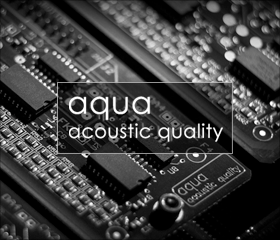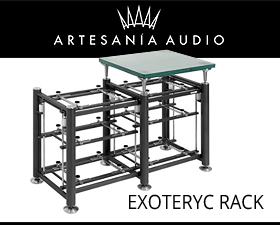Forgive the goofy title. My long background in advertising still has me believing that I need an interesting headline to get people to read the body copy. And while I don't want to call Amir out for one on one debate (I suspect he's significantly smarter than I am and I hate to lose...). I do think he would be a great candidate to fill in the blanks below and challenge the logic, particularly as they relate to setting up a server in Windows. Care to join the party, Amir?
With that said, here's the story...
Doing A Computer-Based Music Server, My Way (ie: Getting Ponked)
I suspect the management here at What’s Best got together and said something like “we need to find something constructive for Phelonious to do.” Nevertheless, I’m honored that anyone would think my humble contribution could be the start of anything constructive. While I will try my best to fluff this piece up with all the dark humor and utterly irrelevant asides I can come up with, at its core it will be a short story because for me, the process of setting up, configuring and operating a computer-based music server looks like this:
2X1TB external hard drives>Mac/iTunes>DAC of choice>your existing system
You can, of course, do all of this on a PC, and my understanding is that it is only a bit more complicated, but I’m a Mac guy. And while I have a modern Mac that will run Windows, in another window (the gist of the old legal challenge…), while running OSX programs...well, running Windows on a Mac is like running Yugo on a Ferrari (my apologies, Amir. I couldn’t resist ?). I’ll count on Amir to dress the Windows.
OK, back to the outline:
2X1TB external hard drives>Mac/iTunes>DAC of choice>your existing system
Why two drives? One of them stays in a closet (a closet in someone else’s house would be better) and only comes out for occasional backups, the occasion being whenever I’ve added enough new music that re-ripping it would be too time consuming.
iTunes? Are You Serious?
Why iTunes? The more pertinent question would be why not? It is free, powerful and versatile. It can be configured, in a click, to be a simple list of its database or an elegant, graphic flow of album covers. You can parse the data just about any way you see fit – song, genre, artist, album, composer, file type, or all of the above. It rips, copies and converts to other formats (not FLAC, but that’s easy to get around) seamlessly, transparently and without error (if you’re using error correction. It’s a great piece of software.
But some people believe other players sound better. This is a pretty tough case to make, given that a media player’s only job, beyond its database and human interface, is to move digital data from one place to another. It shouldn’t “sound” at all. Yet some hear. I believe they are hearing deviations in the data. In older versions of Windows, my understanding is that you get them automatically if you don’t work around them. In iTunes, on a Mac, getting and keeping bit perfect for any given sample rate is very simple: Go to Audio Midi Setup in OSX and tell it what you want. OSX doesn’t adjust rates automatically, though, it downconverts or upconverts to whatever your settings are and then your data is no longer bit-perfect. This problem is addressed through the use of programs like Amarra and Pure Music, which provide automatic switching, and I personally think that is their only advantage. Quite a few folks out there seem to think these programs “sound” better than iTunes. I respectfully disagree. I’ve tried both of them and when all other things are equal, I hear no differences between these programs and iTunes. Pure Media is a worthwhile investment if you plan to have hi-res files in your system. And if it sounds better to you too, good for you. The bar it sticks on top of iTunes is goofy-looking but that, and the $129 is a small price to pay if you think it sounds better.
Will A Really Weak Computer Give You Stronger Sound?
So can it really be that simple? Yes, but you can complicate it if you like through the process of system optimization. In a nutshell, it involves minimizing the processor activity going on while your computer is playing music. At the extreme, it requires a system dedicated to music playback, with solid state hard drives and maybe even an upgraded power supply. There is some logic to the theory: more system activity means more electrical activity and more hard disk activity, resulting in more noise that could be carried, with the data, to your analog systems. I just think a more effective solution is galvanic isolation. I use a digital transport that isolates, re-clocks, converts usb to optical, coax and AES/EBU, and then sends optical to my active speakers, coax to my headphone system. It sounds great and it doesn’t hobble a computer.
The Jukebox Of The Gods
I guess the biggest question, or it should be, anyway, is what does my listening gain from all of this?
A) It sounds great.
B) I can walk into my listening room, type “So What” into a little box, and up pops the version from the original CD release of Kind of Blue, the KOB re-master, a couple of live versions and a couple of duplicates from boxed sets. And that’s just Miles. I’ll get a few covers, too.
Yeah, I know: And I call you guys obsessive…
P
With that said, here's the story...
Doing A Computer-Based Music Server, My Way (ie: Getting Ponked)
I suspect the management here at What’s Best got together and said something like “we need to find something constructive for Phelonious to do.” Nevertheless, I’m honored that anyone would think my humble contribution could be the start of anything constructive. While I will try my best to fluff this piece up with all the dark humor and utterly irrelevant asides I can come up with, at its core it will be a short story because for me, the process of setting up, configuring and operating a computer-based music server looks like this:
2X1TB external hard drives>Mac/iTunes>DAC of choice>your existing system
You can, of course, do all of this on a PC, and my understanding is that it is only a bit more complicated, but I’m a Mac guy. And while I have a modern Mac that will run Windows, in another window (the gist of the old legal challenge…), while running OSX programs...well, running Windows on a Mac is like running Yugo on a Ferrari (my apologies, Amir. I couldn’t resist ?). I’ll count on Amir to dress the Windows.
OK, back to the outline:
2X1TB external hard drives>Mac/iTunes>DAC of choice>your existing system
Why two drives? One of them stays in a closet (a closet in someone else’s house would be better) and only comes out for occasional backups, the occasion being whenever I’ve added enough new music that re-ripping it would be too time consuming.
iTunes? Are You Serious?
Why iTunes? The more pertinent question would be why not? It is free, powerful and versatile. It can be configured, in a click, to be a simple list of its database or an elegant, graphic flow of album covers. You can parse the data just about any way you see fit – song, genre, artist, album, composer, file type, or all of the above. It rips, copies and converts to other formats (not FLAC, but that’s easy to get around) seamlessly, transparently and without error (if you’re using error correction. It’s a great piece of software.
But some people believe other players sound better. This is a pretty tough case to make, given that a media player’s only job, beyond its database and human interface, is to move digital data from one place to another. It shouldn’t “sound” at all. Yet some hear. I believe they are hearing deviations in the data. In older versions of Windows, my understanding is that you get them automatically if you don’t work around them. In iTunes, on a Mac, getting and keeping bit perfect for any given sample rate is very simple: Go to Audio Midi Setup in OSX and tell it what you want. OSX doesn’t adjust rates automatically, though, it downconverts or upconverts to whatever your settings are and then your data is no longer bit-perfect. This problem is addressed through the use of programs like Amarra and Pure Music, which provide automatic switching, and I personally think that is their only advantage. Quite a few folks out there seem to think these programs “sound” better than iTunes. I respectfully disagree. I’ve tried both of them and when all other things are equal, I hear no differences between these programs and iTunes. Pure Media is a worthwhile investment if you plan to have hi-res files in your system. And if it sounds better to you too, good for you. The bar it sticks on top of iTunes is goofy-looking but that, and the $129 is a small price to pay if you think it sounds better.
Will A Really Weak Computer Give You Stronger Sound?
So can it really be that simple? Yes, but you can complicate it if you like through the process of system optimization. In a nutshell, it involves minimizing the processor activity going on while your computer is playing music. At the extreme, it requires a system dedicated to music playback, with solid state hard drives and maybe even an upgraded power supply. There is some logic to the theory: more system activity means more electrical activity and more hard disk activity, resulting in more noise that could be carried, with the data, to your analog systems. I just think a more effective solution is galvanic isolation. I use a digital transport that isolates, re-clocks, converts usb to optical, coax and AES/EBU, and then sends optical to my active speakers, coax to my headphone system. It sounds great and it doesn’t hobble a computer.
The Jukebox Of The Gods
I guess the biggest question, or it should be, anyway, is what does my listening gain from all of this?
A) It sounds great.
B) I can walk into my listening room, type “So What” into a little box, and up pops the version from the original CD release of Kind of Blue, the KOB re-master, a couple of live versions and a couple of duplicates from boxed sets. And that’s just Miles. I’ll get a few covers, too.
Yeah, I know: And I call you guys obsessive…
P
















